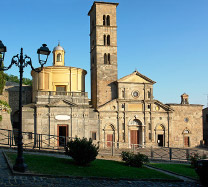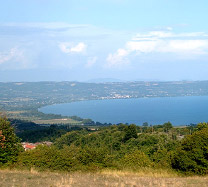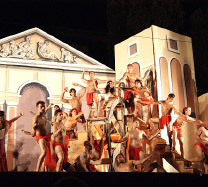B&B Predio San Fernando

Bolsena Lake
Bolsena Lake lies in the centre of a very historical, mainly medieval area with distant Etruscan origins. Bounded by Monti Volsini to the north, the lake is the largest crater in Italy and contains two islands, Bisentina and Martana. The lake is subject to 'sesse', a local word that describes fluctuations in the water level similar to very small tides. Terraces around the fish-filled lake are covered with woods, vineyards and olive groves.
Bolsena Lake has also been declared the cleanest lake in Europe.
Its basin and its endowed lakefront allow the tourists to spend cultural and joyful holidays.
Starting from Bolsena and wandering through the panoramic street around the lake, you can come across many colourful towns: Montefiascone, with its stunning lake panorama, Marta, a fishermen’s town, Capodimonte, Valentano, Gradoli, Grotte di Castro, a beautiful medieval borough and San Lorenzo Nuovo, a perfect example of 18th century urbanistic settlement (a rare eight sided square is the town center).
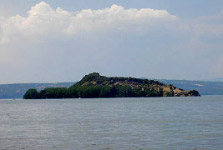 Bolsena overlooks the volcanic lake from a hilltop. The olive-covered lake shores have been a holiday place since ancient times.
Bolsena overlooks the volcanic lake from a hilltop. The olive-covered lake shores have been a holiday place since ancient times. The town was conquered by the Romans in 280 B.C. but still retains Etruscan walls dating from the 4th c. B.C. and a small temple on the hills behind the town. Surviving remains of the Roman period include an amphitheatre, baths, bridges and roads. The town became a place of medieval Christian pilgrimage in 1264 when the miracle of Corpus Domini took place in the collegiate church of Santa Cristina (11th c.), which is built over a catacomb. This charming church contains the sepulchre of Santa Cristina and a chapel known as Cappella del miracolo, which houses an altar stained with eucharistic blood.
Bolsena had another reason to be famous with the transit of wanderings who went from north towards Roma through the Francigena road, that from Siena identifies with the Cassia road, previously runned along from Longobardi.
Bolsena has nowadays the typical look of a small medieval village.
In wintertime little more than 4.000 persons reside there and the quiet is hardly broken by the traffic of the Cassia road and by visitors with religious or studious intent.
From the springtime, the buses with students’ tours animate the lake-front and the buses with tourists invades Santa Cristina place to visit the catacombs and the Eucharistical Miracle altar.
In summer is possible to practise every kind of aquatic-sport: boat-racing, water-ski, swimming, fishing, wind-surfing and sailing.
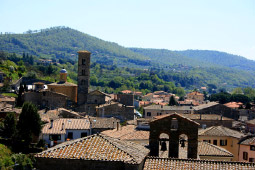 The oaks-chestnut trees-hornbeams-woods on the hills around Bolsena allow the holiday-makers to make many excursions and here a park, realized by the municipal corporation, offers a place for picnics and free camping.
The oaks-chestnut trees-hornbeams-woods on the hills around Bolsena allow the holiday-makers to make many excursions and here a park, realized by the municipal corporation, offers a place for picnics and free camping. The remains of ancient settlements and of the etruscan necropolis, are the fascination for archaelogists, students and tourists. The numerous restaurants serves typical latium dishes with fish of the lake and agreeable wines; the most appreciated wines are the red ones: Aleatico and Cannaiola and the white one Est!Est!Est!

